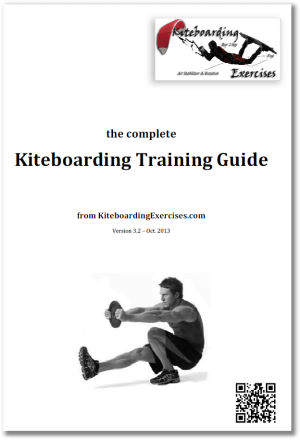How Exercise Makes You a Better Kitesurfer
How Exercise Makes You a Better Kitesurfer
by Jake Mitchell
Arguably one of the most common questions posed by those unfamiliar with kiteboarding is, "Does it take a lot of strength?" The default answer is 'no', as that question is almost always in reference to the process of attaching yourself to the harness, which alleviates much of the pull on your arms. In reality, kitesurfing does require power, along with core strength, balance, coordination, and stability. If your aspirations are limited to merely riding, then physical fitness will have very little impact on your riding (minus your weight, which requires larger kites and kiteboards). If you want to jump, surf, or pursue any loftier feats, physical prowess is crucial for success. Like any sport, the more practice you put into kiteboarding, the better your riding will be. One factor that is so often overlooked though when bettering your kiting ability is preparing off of the water. While this can certainly involve trampoline training for building muscle memory and spatial awareness, your kiteboarding can be greatly enhanced by basic exercise and stretching.
 In every sport, the most dedicated participants set up a conditioning routine, focusing on strength building, muscle toning, and stretching exercises that directly translate to performance. Kiteboarding is no different. Whether strengthening the abdominal muscles for jumping, or building arm and core muscle for unhooked tricks, a workout dedicated specifically towards your particular riding style will see you progressing that much more. Not only will you have better follow through, but more energy on the water to continue trying those new tricks. While some riders focus on more strength training, emphasizing specific muscles, for the majority of kitesurfers functional training focusing on balance, coordination, and stability is much more important. This more holistic approach is also paramount for avoiding injury. Although the greatest strain may come under a heavy load (such as a hard landing), which muscle is important for, it is largely a function of the three above identified attributes. For example, building up one part of the knee while neglecting another area is likely to lead to injury in an intensive, load-bearing crash or landing, as the muscles are likely not pulling at the same strength. Building up strength will help buffer against hard impacts and falls, making sure you stay on the water this summer rather than the couch. The below guide has been specifically tailored to kiteboarding:
In every sport, the most dedicated participants set up a conditioning routine, focusing on strength building, muscle toning, and stretching exercises that directly translate to performance. Kiteboarding is no different. Whether strengthening the abdominal muscles for jumping, or building arm and core muscle for unhooked tricks, a workout dedicated specifically towards your particular riding style will see you progressing that much more. Not only will you have better follow through, but more energy on the water to continue trying those new tricks. While some riders focus on more strength training, emphasizing specific muscles, for the majority of kitesurfers functional training focusing on balance, coordination, and stability is much more important. This more holistic approach is also paramount for avoiding injury. Although the greatest strain may come under a heavy load (such as a hard landing), which muscle is important for, it is largely a function of the three above identified attributes. For example, building up one part of the knee while neglecting another area is likely to lead to injury in an intensive, load-bearing crash or landing, as the muscles are likely not pulling at the same strength. Building up strength will help buffer against hard impacts and falls, making sure you stay on the water this summer rather than the couch. The below guide has been specifically tailored to kiteboarding:
Kiteboarding-Exercises-Complete-Training-Guide-V3.pdf
While I've historically been rather lazy off of the water, this year I'm going to begin preparing off the water to better the time I spend on it, beginning with the above guide. Join me in this process, and make this year one of the most successful on record.
